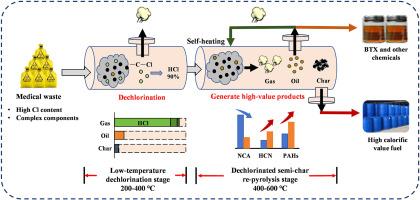医疗废弃物分阶段热解生成高价值产品:组分间相互作用对氯迁移和轻化合物形成的影响
IF 10
1区 环境科学与生态学
Q1 ENGINEERING, ENVIRONMENTAL
引用次数: 0
摘要
医疗废物危害很大,其数量每年都在增加。分阶段热解是一种既能提高热解产物质量又能减少污染物产生的热解技术,在医疗废弃物的高效处置和资源化利用方面具有巨大潜力。然而,医疗废物的成分非常复杂。多组分原料共热解过程中存在相互作用,显著影响热解行为和产物分布。因此,本研究研究了医疗废物分级热解的低温脱氯阶段(阶段一)和脱氯半焦重热解阶段(阶段二)的相互作用机理,为医疗废物的清洁可持续处理提供理论依据。在低温脱氯阶段,HCl与纱布在气相中相互作用,降低了纱布的分解温度,释放出大量的含氧挥发物。HCl还促进了增塑剂的分解,产生氯化烃。气固相互作用部分抑制HCl的释放,导致半炭吸附和固定。在脱氯半焦重热解阶段,气相相互作用加速了含氮芳烃的脱氮。相反,气固相互作用减少了含氧官能团的释放,减弱了CO和CO2的生成。此外,气相和气固相互作用促进了油和炭中有机氯的脱除,生成CH3Cl,其中气固相互作用的影响更为显著。本研究揭示了组分间相互作用对医疗废弃物分阶段热解过程中氯迁移和轻化合物形成的影响,为废弃物高效处理和高价值产品生成提供理论和技术支持。本文章由计算机程序翻译,如有差异,请以英文原文为准。


Staged pyrolysis of medical waste for high-value product generation: Impact of inter-component interactions on chlorine migration and light compounds formation
Medical waste is highly hazardous, with its volume increasing annually. Staged pyrolysis is a pyrolysis technique that can improve the quality of pyrolysis products while reducing the generation of pollutants, which shows enormous potential for efficient disposal and resource recovery of medical waste. However, medical waste exhibits a highly complex composition. Interactions occur during the co-pyrolysis of multi-component feedstocks, significantly influencing pyrolysis behavior and product distribution. Therefore, this study investigated the interaction mechanisms during the low-temperature dechlorination stage (Stage I) and dechlorinated semi-char re-pyrolysis stage (Stage II) of medical waste staged pyrolysis, providing a theoretical basis for the clean and sustainable treatment of medical waste. In the low-temperature dechlorination stage, HCl interacted with gauze in the gas phase, lowering its decomposition temperature and releasing significant oxygenated volatiles. HCl also promoted the breakdown of plasticizers, producing chlorinated hydrocarbons. Gas-solid interactions partially inhibited HCl release, leading to adsorption and fixation on semi-char. In the dechlorinated semi-char re-pyrolysis stage, gas-phase interactions accelerated the denitrogenation of nitrogen-containing aromatics. In contrast, gas-solid interactions reduced the release of oxygenated functional groups, weakening CO and CO2 production. Additionally, gas-phase and gas-solid interactions promoted the removal of organic chlorine from oil and char, generating CH3Cl, with the gas-solid interactions having a more significant impact. This study revealed the impact of inter-component interactions on chlorine migration and light compounds formation during staged pyrolysis of medical waste, offering theoretical and technical support for efficient waste treatment and high-value product generation.
求助全文
通过发布文献求助,成功后即可免费获取论文全文。
去求助
来源期刊

Journal of Cleaner Production
环境科学-工程:环境
CiteScore
20.40
自引率
9.00%
发文量
4720
审稿时长
111 days
期刊介绍:
The Journal of Cleaner Production is an international, transdisciplinary journal that addresses and discusses theoretical and practical Cleaner Production, Environmental, and Sustainability issues. It aims to help societies become more sustainable by focusing on the concept of 'Cleaner Production', which aims at preventing waste production and increasing efficiencies in energy, water, resources, and human capital use. The journal serves as a platform for corporations, governments, education institutions, regions, and societies to engage in discussions and research related to Cleaner Production, environmental, and sustainability practices.
 求助内容:
求助内容: 应助结果提醒方式:
应助结果提醒方式:


